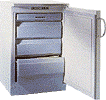 |
Freezing |  |
When freezing liquids, leave one-half inch of headspace at the top of the container to allow for expansion.
Whenever you have extra broth, pour it into a plastic ice cube tray and freeze. Once frozen they can be removed and stored in the freezer in a plastic bag. They can be added to soups or used to saute foods. When freezing foods, force or draw out as much air as possible, seal tightly, label and freeze immediately for best results. It's best not to refreeze foods that have been frozen already and thawed, as this increases the risk of contamination by harmful bacteria. To freeze a frosted cake, put it in the freezer without any wrapping. Once it has frozen, wrap it and replace. This keeps the frosting from sticking to the wrapping. For pretty ice cubes, drop berries or small pieces of fruit into the compartments of an ice cube tray. Fill the tray with water and freeze. To make fun stirrers, put vegetable or fruit chunks on small skewers. When you defrost your freezer, wipe the sides with glycerin (available at drug stores). The ice will come off easier next time you defrost. Peppers are some of the few vegetables that can be frozen without blanching first. Just cut into desired size, put into a freezer bag or container, and freeze. Allow space between foods in the refrigerator or freezer for air to circulate and faster chilling. Divide large amounts of foods to be refrigerator or frozen into shallow containers for faster chilling. To freeze raw eggs, add 1/8 teaspoon salt for every two whole eggs that have been cracked into a container and cover tightly. Never refrigerate or freeze homestuffed whole poultry (still on carcass); it may become contaminated due to slow freezing or thawing. To freeze fresh berries, set them 1/4 inch apart on a baking sheet; freeze; pour into freezer bags, seal, and store in freezer. Don't freeze cabbage, lettuce, or other raw leafy greens, cucumbers, celery, or radishes - they'll be mushy when thawed. Freezing adversely affects the texture of cottage cheese, sour cream, cooked eggs, yogurt, and mayonnaise. Before returning an opened carton of ice cream to the freezer, press plastic wrap onto the surface of the ice cream to prevent ice crystals from forming. Place fresh ginger root in a plastic bag and store it in the freezer. It will keep for months. Just grate the amount you need and return it to the freezer. To freeze food in ziptop freezer bags, put cool food into the bag. Push out as much of the air from the bag as you can then seal the bag, leaving a small opening. Put a straw into the opening and suck out the remaining air, then totally seal the bag. Drop dollops of whipped cream onto a cookie sheet and freeze, Transfer them to plastic bags and return to freezer. They'll thaw in 20 minutes. Milk and cream can be frozen but will separate when thawed. Heavy cream will not whip when thawed. Freeze milk up to 1 month and cream up to 2 months. Dairy products can be safely frozen. Their quality, however, may be affected depending on storage times. Freeze high quality butter six to nine months and margarine for 12 months in original coated paper packages. Do not freeze whipped butter or margarine. Cream cheese, dry cottage cheese and farmer's cheese keep in the freezer three months. Frozen creamed cottage cheese breaks down and becomes mushy. Use it in cheesecake, freeze and then blend it in the blender. Cream will be crumbly after thawing. Use it in spreads and dips. To freeze hard cheese such as cheddar, Colby, Edam, Gouda, Swiss or brick, cut and wrap in small pieces of less than one pound, or grate and freeze in freezer-weight bags or rigid freezer containers. Moisture may cause a mottled color. Before using, thaw it the refrigerator. Freeze processed cheese food products, in a loaf or in slices, up to four months. Blue cheese freezes for three months, but it becomes crumbly after thawing. Wrap it well to prevent odors. Freeze light and heavy cream, evaporated milk and half-and-half for up to two months. Heavy cream may not whip after thawing. Remove original wrappings or can and store in plastic freezer containers or glass jars. Leave one-inch headspace. Thaw in the refrigerator and use for cooking. Freeze whipped cream for one month in dollops or mounds. Freeze firm on a cookie sheet, then place in a freezer container. Make one layer, cover with waxed paper, and place second layer on top. Seal in airtight wrap and store in freezer. Place on top of dessert 10 minutes before serving. Freeze and store milk one month. Allow room for expansion in the freezer container. Thaw in the refrigerator. Freezing affects flavor and appearance, but milk, buttermilk, sour cream and yogurt are all right for baking. To successfully freeze eggs, break the eggs and add one T. milk or water per egg and a dash of salt. Mix well and pour into freezer container. Thaw in the refrigerator and use for scrambled eggs, French toast, pancakes or waffles. |
! Disclaimer !
Return to Cooking Hints Index Page